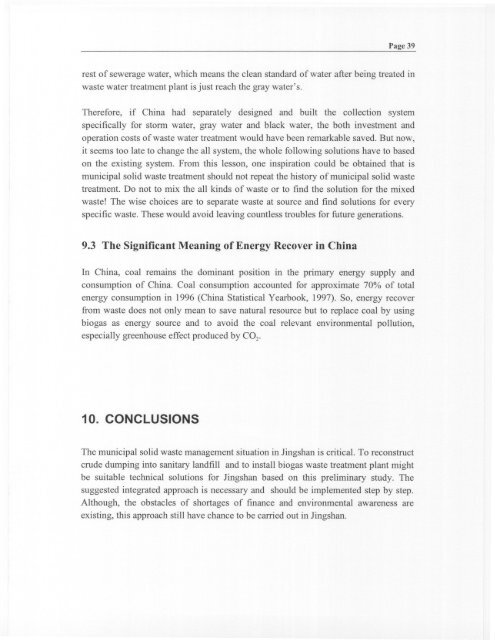Page 389. DISCUSSIONS AND REFLECTIONSIn this charter, <strong>the</strong> obstac1es and opportunities for carry<strong>in</strong>g out <strong>the</strong> <strong>in</strong>tegratedapproach are discussed. Also, some associated questions with <strong>municipal</strong> <strong>solid</strong> <strong>waste</strong><strong>management</strong> are thought over aga<strong>in</strong> dur<strong>in</strong>g this <strong>the</strong>sis work. These questions areaddressed to betteTunderstand <strong>the</strong> <strong>the</strong>sis.9.1 The Obstacles and OpportunitiesShortage <strong>of</strong> f<strong>in</strong>ance to <strong>in</strong>vest <strong>the</strong> <strong>municipal</strong> <strong>solid</strong> <strong>waste</strong> treatment plant and sort<strong>in</strong>g<strong>waste</strong> can be Olle<strong>of</strong> big obstac1es<strong>in</strong> implement<strong>in</strong>g this <strong>in</strong>tegrated approach. But dueto <strong>the</strong> rapid economic growth rate, <strong>the</strong> <strong>in</strong>ternational fund<strong>in</strong>g is enormously flow<strong>in</strong>g <strong>in</strong>Ch<strong>in</strong>a. So, it is not very difficult to borrow <strong>the</strong> <strong>in</strong>ternational f<strong>in</strong>ance, especially for <strong>the</strong>loan <strong>of</strong> import<strong>in</strong>g equipment.Lack <strong>of</strong> environmental awareness is Olle <strong>of</strong> <strong>the</strong> o<strong>the</strong>r big obstac1es. The <strong>waste</strong><strong>management</strong> and sort<strong>in</strong>g <strong>waste</strong> education difficult to be carry out at <strong>the</strong> verybeg<strong>in</strong>n<strong>in</strong>g. So, <strong>the</strong> <strong>municipal</strong>ity has to persist, especially when no obvious resultwould be expected dur<strong>in</strong>g <strong>the</strong> <strong>in</strong>itial stages. Management should be competent; ifpeople see <strong>the</strong> <strong>waste</strong> separated by <strong>the</strong>m to be mixed <strong>in</strong> some transfer stations orlandfill, <strong>the</strong>n previous efforts will be lost and <strong>the</strong> confidence <strong>of</strong> some residents will bediscouraged, and <strong>municipal</strong>ity willlose credit with<strong>in</strong> residents and also make difficultto implement aga<strong>in</strong>. Step by step, let people see <strong>the</strong> achievement, even smallachievement. In addition, residents <strong>of</strong> J<strong>in</strong>gshan relatively rely on <strong>the</strong> localgovemment, <strong>the</strong>refore, <strong>the</strong> comb<strong>in</strong>ation <strong>of</strong> education, economic <strong>in</strong>centives andenvironmental restrictions perhaps can be help to sort <strong>waste</strong> and built <strong>the</strong>environmental concerns with<strong>in</strong> residents.Although, Ch<strong>in</strong>a is fac<strong>in</strong>g a lot <strong>of</strong> problems both on economy and environment, <strong>the</strong>rapid potential <strong>of</strong> development <strong>of</strong> Ch<strong>in</strong>a likely gives us <strong>the</strong> enough space <strong>of</strong>imag<strong>in</strong>ation for optimal future, this is also suitable for J<strong>in</strong>gshan <strong>case</strong>.9.2 Lessons from <strong>the</strong> Municipal Sewerage Water Treatment SystemAt present, Ch<strong>in</strong>ese cities have adopted <strong>the</strong> model <strong>of</strong> <strong>the</strong> lead<strong>in</strong>g <strong>in</strong>dustri al countriesby us<strong>in</strong>g <strong>the</strong> same sewerage water collection system to collection whole <strong>municipal</strong>sewer <strong>in</strong>c1ud<strong>in</strong>g storm water, gray water and black water, each city has at least Olle<strong>waste</strong> water treatment plant, just because <strong>the</strong> exist<strong>in</strong>g sewerage water collectionsystem mixed storm, gray and black <strong>waste</strong>, <strong>the</strong> work load <strong>of</strong> <strong>waste</strong> water treatmentplant is added up to a couple <strong>of</strong> times or more than ten times sometimes. And <strong>the</strong>function <strong>of</strong> <strong>waste</strong> water treatment plant is only to separate <strong>the</strong> black water out <strong>of</strong> <strong>the</strong>
Page 39rest <strong>of</strong> sewerage water, which means <strong>the</strong> dean standard <strong>of</strong>water<strong>waste</strong> water treatment plant is just reach <strong>the</strong> gray water's.after be<strong>in</strong>g treated <strong>in</strong>Therefore, if Ch<strong>in</strong>a had separately designed and built <strong>the</strong> collection systemspecifically for storm water, gray water and black water, <strong>the</strong> both <strong>in</strong>vestment andoperation costs <strong>of</strong><strong>waste</strong> water treatment would have been remarkable saved. But now,it seems too late to change <strong>the</strong> all system, <strong>the</strong> whole follow<strong>in</strong>g solutions have to basedon <strong>the</strong> exist<strong>in</strong>g system. From this lesson, Olle<strong>in</strong>spiration could be obta<strong>in</strong>ed that is<strong>municipal</strong> <strong>solid</strong> <strong>waste</strong> treatment should not repeat <strong>the</strong> history <strong>of</strong> <strong>municipal</strong> <strong>solid</strong> <strong>waste</strong>treatment. Do not to mix <strong>the</strong> all k<strong>in</strong>ds <strong>of</strong> <strong>waste</strong> or to f<strong>in</strong>d <strong>the</strong> solution for <strong>the</strong> mixed<strong>waste</strong>! The wise choices are to separate <strong>waste</strong> at source and f<strong>in</strong>d solutions for everyspecific <strong>waste</strong>. These would avoid leav<strong>in</strong>g countless troubles for future generations.9.3 The Significant Mean<strong>in</strong>g <strong>of</strong> Energy Recover <strong>in</strong> Ch<strong>in</strong>aIn Ch<strong>in</strong>a, coal rema<strong>in</strong>s <strong>the</strong> dom<strong>in</strong>ant position <strong>in</strong> <strong>the</strong> primary energy supply andconsumption <strong>of</strong> Ch<strong>in</strong>a. Coal consumption accounted for approximate 70% <strong>of</strong> totalenergy consumption <strong>in</strong> 1996 (Ch<strong>in</strong>a Statistical Yearbook, 1997). So, energy recoverfrom <strong>waste</strong> does not only mean to save natural resource but to replace coal by us<strong>in</strong>gbiogas as energy source and to avoid <strong>the</strong> coal relevant environmental pollution,especially greenhouse effect produced by COz.10. CONCLUSIONSThe <strong>municipal</strong> <strong>solid</strong> <strong>waste</strong> <strong>management</strong> situation <strong>in</strong> J<strong>in</strong>gshan is critical. To reconstructcrude dump<strong>in</strong>g <strong>in</strong>to sanitary landfill and to <strong>in</strong>stall biogas <strong>waste</strong> treatment plant mightbe suitable technical solutions for J<strong>in</strong>gshan based on this prelim<strong>in</strong>ary <strong>study</strong>. Thesuggested <strong>in</strong>tegrated approach is necessary and should be implemented step by step.Although, <strong>the</strong> obstades <strong>of</strong> shortages <strong>of</strong> f<strong>in</strong>ance and environmental awareness areexist<strong>in</strong>g, this approach still have chance to be carried out <strong>in</strong> J<strong>in</strong>gshan.
















